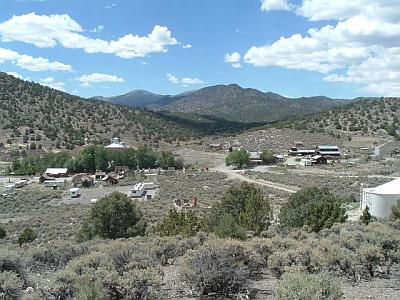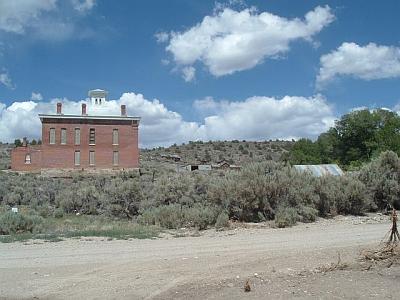7.0 Belmont
7.1 Risk and Hazard Assessment
Belmont is located at nearly 7,400 feet in elevation in northern Nye County on the east side of the Toquima Range, at the southern end of Monitor Valley, adjacent to the Humboldt-Toiyabe National Forest. The community is situated adjacent to south-facing and moderately steep slopes. The population of Belmont is small and not tracked by the Nevada State Demographer (Nevada State Demographer, 2003). The assessment resulted in classifying Belmont in High Community Hazard category (73 points). This rating was primarily attributed to limited access, inadequate defensible space, relatively steep slopes, and heavy fuels. The specific findings for each of the wildland fire assessment parameters are reported below, and shown in Table 7-2.
7.1.1 Community Design
The wildland-urban interface around Belmont is described as an intermix condition: structures are scattered throughout the wildland area with no clear line of demarcation between wildland fuels, the buildings, and open space throughout the community. All of the 29 residences assessed were on parcels between one and ten acres in size. As such, most structures were surrounded by vegetation.
- Roads: Belmont is a relatively remote community accessed by State Route 82. This primary access road is paved and is between twenty and 24 feet in width. Many roads within the community have a grade steeper than five percent. The majority of the roads have adequate turnaround space for fire suppression equipment.
- Signage: Secondary streets in the community are all unpaved and do not have clearly visible street signs. No house numbers were observed on any of the homes. The presence of street signs and clearly visible building addresses are an important aid for fire and emergency responders unfamiliar with the area.
- Utilities: All of the utilities were above ground. Power lines had been properly maintained to minimize the possibility of vegetation ignition due to sparking power lines during windstorms.
7.1.2 Construction Materials
All but one of the homes observed in the interface area were built with ignition resistant roofing materials and all but five of the homes were built with ignition resistant siding materials. Forty-one percent of the homes observed had unenclosed balconies, porches, decks, or other architectural features that could create drafty areas where sparks and embers can accumulate, smolder, and ignite, and rapidly spread fire to the home.
7.1.3 Defensible Space
Only 38 percent of the homes met the minimum recommended defensible space guidelines for landscaping to help protect the home from damage or loss during a wildfire.
7.1.4 Suppression Capabilities
Wildfire Protection Resources
At the time of the interview for this assessment, Belmont reported a seventeen member Volunteer Fire Department at one fire station. Table 7-1 lists the types of wildfire resources, cooperating partners, and equipment available to Belmont in the event of a reported wildland fire. In addition to the current equipment, in 2004 the Nye County Commissioners approved the purchase of a four-wheel drive emergency vehicle equipped with a 2,000-gallon water tank and a 1,000 gpm pump for the Belmont Volunteer Fire Department.
| Type of Equipment | Amount of Equipment | Cooperating Partner (Resource Location) |
|---|---|---|
| Type 3 Engine Water Tender (4,000 gal.) |
1 1 |
Belmont Volunteer Fire Department (Belmont) |
| Type 6 Engine Type 3 Engine |
1 1 |
Manhattan Volunteer Fire Department (Manhattan) Tonopah Volunteer Fire Department (Tonopah) |
| Source: Personal conversation with Chief Rich Sauer, Belmont VFD (June 28, 2004) | ||
Additional mutual aid resources were reported to be available through the fire departments in Hadley, Manhattan, and Tonopah, dispatched through the Nye County Sheriff Dispatch Center in Tonopah. Resources are also available from the Nevada Division of Forestry Tonopah Conservation Camp as dispatched through the Sierra Front Interagency Dispatch in Minden. Bureau of Land Management and the US Forest Service resources are dispatched through the Central Nevada Interagency Dispatch Center. It is important to note that the actual number and type of suppression resources available to respond from neighboring fire departments and agencies is dependent upon the resources on hand at the time of the wildland fire call.
Water Sources and Infrastructure
Water available for fire suppression in Belmont includes:
- 500 gpm hydrants within 500 feet of structures,
- One 12,000 gallon tank, and
- Two ponds on private property.
The water system is operated by gravity and electric pumps. There is no emergency back-up generator.
Detection and Communication
Belmont is a small, remote community. Where there is cell phone reception, fires can be reported by calling 911. Fires are reported to the Nye County Sheriff’s Office in Tonopah, which serves as fire dispatch.
The radio frequency used by the Belmont Volunteer Fire Department was reported to be compatible with neighboring agencies but the fire department reported no access to state mutual aid frequencies. Many gaps in radio coverage due to the terrain were reported. A better repeater system is needed to alleviate the problem.
Fire Protection Personnel Qualifications
All volunteer firefighters have been trained to National Fire Protection Administration Firefighter I and II standards.
Work Load
The Belmont Volunteer Fire Department responded to three calls in 2003. Only one of the calls was for a wildland / brush fire.
Financial Support
Financial support for the Belmont Volunteer Fire Department comes primarily from the Nye County General Fund.
Community Preparedness
The Belmont Volunteer Fire Department has a voluntary brush clearance program on private property and maintains a pre-attack plan. The Nye County Local Emergency Planning Committee maintains an Emergency Plan for hazardous materials and an All Risk County Plan.
7.1.5 Factors Affecting Fire Behavior
Vegetation, as well as dead and down fuels, and topographical features contributes to the potential fire hazard in the wildland-urban interface. Belmont lies in a north-south oriented canyon with twenty to thirty percent slopes. During the summer months, there can be strong southwest and west upslope winds. Winds can be erratic during summer thunderstorms. Fuels in the community were dominated by moderately dense pinyon pine and juniper on the east facing slopes and sagebrush and rabbitbrush on the west facing slopes. The sagebrush was from two to five feet tall and the rabbitbrush was from one to three feet tall. A low drainage in the center of town was occupied with basin big sagebrush up to six feet tall. The interface fuel hazard ranged from high to extreme. The fuel hazard condition was mapped for Belmont and photo points were established to monitor the fuel hazard condition over time (Figures 7-2 and 7-3).
7.1.6 Fire Behavior Worst-case Scenario
The worst-case scenario for Belmont would occur in a year with above normal precipitation and above normal grass production, with a fire starting in the late afternoon southwest of community at the bottom of the canyon. Winds would push a fire through the brush ladder fuels allowing flames to extend into pinyon pine and juniper crowns. Spotting could occur up to one-quarter mile ahead of the main fire front with flames six to more than twenty feet in length. A fire spread rate between thirty and 75 feet per minute would be expected. Belmont currently has only one Type 3 engine with additional resources more than thirty minutes away. A fire under these conditions could easily escape initial attack. The canyon topography and winds could act as a chimney and pull the fire rapidly through the community.
7.1.7 Ignition Risk Assessment
There is a high potential for fire ignition and a high potential for structure loss in Belmont due to the continuous fuel loads and lack of defensible space throughout the community. The primary ignition risks in Belmont are from lightning, campfires, and off-highway vehicles. One fire ignition was recorded within 1.5 miles east of the community.
7.2 Risk and Hazard Reduction Recommendations, Roles, and Responsibilities
The Belmont risk and hazard reduction recommendations address the primary concern regarding defensible space and the need for fuel reduction treatments surrounding the community. Other recommendations pertain to community coordination, improving radio communications, and public education efforts that could be initiated to enhance fire safety in Belmont.
7.2.1 Defensible Space Treatments
Defensible space treatments are an essential first line of defense for residential structures. The goal of the treatment is to significantly reduce or remove vegetation within a prescribed distance from structures. (Specific guidelines for defensible space are dependent on fuel type and topography and are given in Appendix E.) Defensible space reduces fire intensity and decreases the potential for loss or damage to structures in the event of an oncoming wildfire.
Property Owner Responsibilities
- Remove, reduce, and replace vegetation around homes according to the guidelines in Appendix E. This area should be kept:
- Lean: There are only small amounts of flammable vegetation,
- Clean: There is no accumulation of dead vegetation or other flammable debris, and
- Green: Existing plants are healthy and green during the fire season.
- Maintain the defensible space condition as needed.
- Immediately remove cleared vegetation to an approved disposal site when implementing defensible space treatments. This material dries quickly and presents a fire hazard if left on site.
- Clear around propane tanks for a minimum distance of ten feet and maintain this area free of accumulated vegetation and combustible materials.
- Remove flammable materials and other debris from the defensible space.
- Store lumber and firewood a minimum distance of thirty feet from structures.
- Install spark arrestors on chimneys.
- Maintain the area beneath unenclosed wood decks and porches free of weeds and flammable debris.
- Prune pinyon and juniper branches a minimum of four feet from the ground (but no more than one-third of the tree canopy) to reduce ladder fuels. Remove all dead and diseased branches and duff from beneath the remaining trees. Remove leaves and debris from roofs and rain gutters.
- If a resident decides to keep some pinyon or juniper trees near the home for aesthetic reasons, no other native trees or ladder fuels should be within a minimum of thirty feet of the crown of the tree.
- Prune tree branches back at least fifteen feet from chimneys, walls, and roofs of structures.
- Where possible wood shake roofs should be replaced with non-combustible shingles.
7.2.2 Fuel Reduction Treatments:
Fuel reduction treatments are applied on a larger scale than defensible space treatments. By permanently changing the fuel structure over large blocks of land to one of lower volume or reduced flammability with a fuel reduction treatment, the expected result in the event of a catastrophic wildfire would be one of reduced capacity for uncontrolled spread through the treated area.
Property Owner Responsibilities
A substantial fuel reduction treatment is needed on private lands within the community to remove or reduce the amount of sagebrush, rabbitbrush, and wood debris from collapsed buildings. The approximate location of the area in need of fuel reduction treatment is shown in Figure 7-1.
- Within the community, shrubs should be thinned to a spacing of two times their height. Trees should be thinned to a spacing equivalent to one and one-half (1-1/2) times the height of the taller trees from crown to crown.
- Mow or remove brush, weeds, and other flammable vegetation growing against fences that adjoin structures in the community.
Belmont VFD Responsibilities
- Mow or otherwise remove all vegetation within ten feet of all fire hydrants to improve visibility and access for firefighters.
7.2.3 Community Coordination:
Coordination among local, state, and federal fire suppression agencies is important in the day-to-day fire prevention activities and becomes critical in the event of a wildland fire. During a fire event, firefighters from other communities and states may be dispatched to areas they have never been before. This is particularly true in areas that have limited fire suppression resources and will most likely be dependent on outside agencies in the event of a catastrophic wildland fire.
Property Owner Responsibilities
- Form a local chapter of the Nevada Fire Safe Council. The Nevada Fire Safe Council proposes to work on solutions that reduce the risk of loss of lives and property from wildfires in Nevada’s communities. Through the establishment of a local Chapter, communities become part of a large information-sharing network that receives notifications of programs and funding opportunities for fire mitigation projects such as those listed in this report. The Nevada Fire Safe Council will accept and manage grants and contracts on the Chapter’s behalf through its non-profit status. The Nevada Fire Safe Council provides assistance and support to communities to complete fire safe plans, set priorities, educate and train community members, and promote success stories of its members. For more information on forming a chapter, contact;
Nevada Fire Safe Council
1187 Charles Drive
Reno, Nevada 89509
(775) 322-2413
www.nvfsc.org
- As an evacuation plan becomes available, citizens should read and become fully knowledgeable of evacuation procedures, fire safety zones, and safety procedures for sheltering in place in the event that evacuation is not possible.
- Assure that residential addresses are visible from the road. The best place to post an address is where the driveway meets the road. Address characters should be at least four inches tall and reflective. Improving the visibility of addresses will facilitate the navigation of unfamiliar neighborhoods for rescue and suppression personnel during a wildfire event.
Belmont VFD Responsibilities
- Participate annually with the US Forest Service and Bureau of Land Management to discuss pre-attack plans for the public lands surrounding Belmont.
- Provide pre-attack plans, including maps of water sources, staging areas, safety zones, etc. to outside agencies that respond to a wildfire event.
- Initiate a program for posting street names with at least four-inch high reflective lettering.
Nye County and Belmont VFD Responsibilities
- Prepare an evacuation plan and post or otherwise distribute this plan to residents. This plan should include information regarding evacuation routes, evacuation procedures, designated fire safe zones, and procedures for sheltering in place in case evacuation becomes infeasible during a fast moving firestorm.
7.2.4 Public Education
Public education focused on increasing community fire safety is critical. A program that explains fire safe measures in clear and emphatic terms will have an impact on residents in the wildland-urban interface. Informed community members will be more inclined to take actions to effectively reduce fuels and other wildfire hazards around their homes and in their neighborhoods.
Belmont VFD Responsibilities
- Contact the BLM Battle Mountain Field Office and the University of Nevada Cooperative Extension for assistance with programs for public education.
- Distribute copies of the publication “Living with Fire” to all property owners. This publication is free of charge. Copies can be requested from the University of Nevada Cooperative Extension.
7.2.5 Equipment and Training
Resources and training for wildfire is a safety issue for firefighters as well as the community. The volunteer fire department needs brush training and equipment to safely do their job because additional fire suppression resources are at least thirty minutes and more likely, one to two hours away.
Belmont VFD Responsibilities
- Obtain access to the state mutual aid frequencies and the frequencies that are compatible with neighboring agencies. Compatible radio frequencies are important for communication between engines during larger fires and are critical to firefighter safety.
- Upgrade personal protection equipment for wildland firefighting. Personal protection equipment includes hard hats, goggles, gloves, fire shelters with cases, and Nomex clothing.
- Obtain wildland firefighting equipment such as Pulaskis, shovels, and McLeods.
- Obtain basic wildland firefighting training and attend annual refresher courses. Ensure that wildfire training and equipment conforms to the National Wildfire Coordinating Group 310-1 standards.
Nye County Responsibilities
- Assist the Belmont Volunteer Fire Department in obtaining grants to improve radio system and communications for Belmont.
- Coordinate with the Belmont Volunteer Fire Department to acquire basic wildland safety gear.
BLM and USFS Responsibilities
- Meet annually with Belmont Volunteer Fire Department to discuss pre-attack plans for the area around Belmont.
- Provide basic wildland fire training to all Belmont VFD Volunteers.
7.2.6 Shaded Fuelbreak
The topography and fuel hazard surrounding Belmont are favorable to the rapid spread of a wildfire. These conditions, coupled with limited local fire suppression resources and the distance of the town from additional firefighting resources warrant the establishment of a shaded fuelbreak around the entire community. Where possible, the treatment area should extend from the ridgelines down to the structures to be protected. Figure 7-1 shows a schematic of the proposed alignment, which will vary in width from 500 and 1,300 feet. The exact location of the shaded fuelbreak should be field surveyed in order to incorporate existing topographic features, natural barriers, and property line constraints.
USFS Responsibilities
- Construct the shaded fuelbreak by thinning trees to a spacing equivalent to one and one-half (1-1/2) times the height of the taller trees from crown to crown. Thin shrubs to a spacing of two times their height. Clear all shrubs within ten feet of the tree crowns that remain.
- Seed the fuelbreak treatment area with perennial grasses and treat it with an acceptable pre-emergent herbicide to prevent annuals from germinating in the first year. Any herbicide application on public lands must be done in accordance with federal guidelines.
Figure 7-1Belmont Suppression Resources, Critical Features, and Proposed Mitigation Projects |
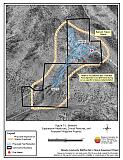 |
Figure 7-2Belmont Fuel Hazard Classification |
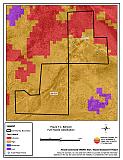 |
Figure 7-3. Belmont Fuel Hazard Photo Points
Photo Point 1. 4271793 N. 511110 E 328°NNW. The fuel load was estimated to range between five and twelve tons per acre. The sagebrush vegetation type was considered a high fuel hazard. The pinyon and juniper vegetation type was generally steeper and considered an extreme fuel hazard adjacent to Belmont.
Photo Point 2. 4271958 N. 510745 E 37°NNE. The sagebrush in this photo was six feet tall and needs to be thinned throughout the community, especially within 100 feet of structures.
Table 7-2Belmont Wildfire Hazard Rating Summary |
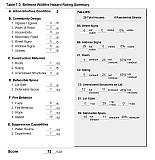 |

